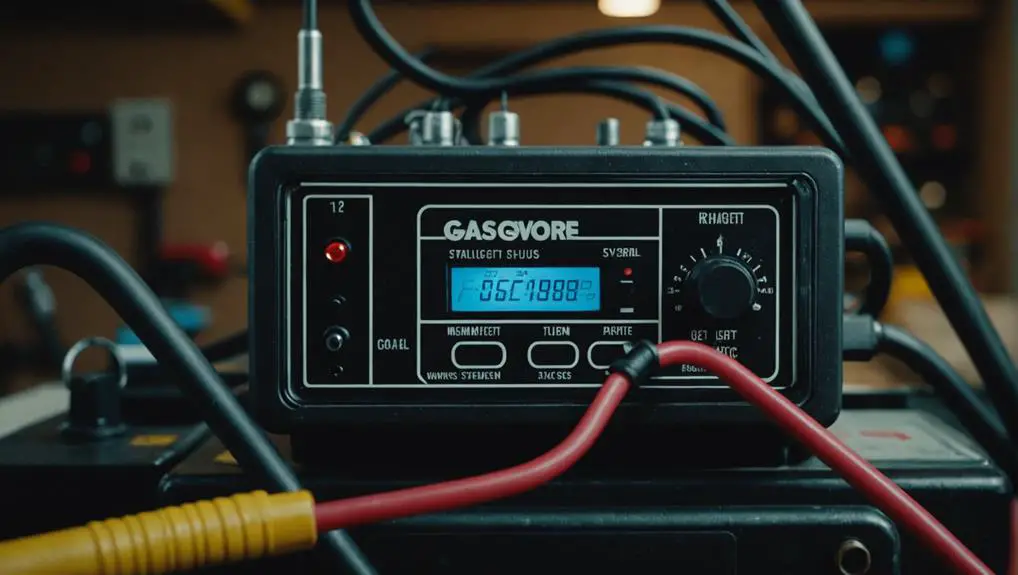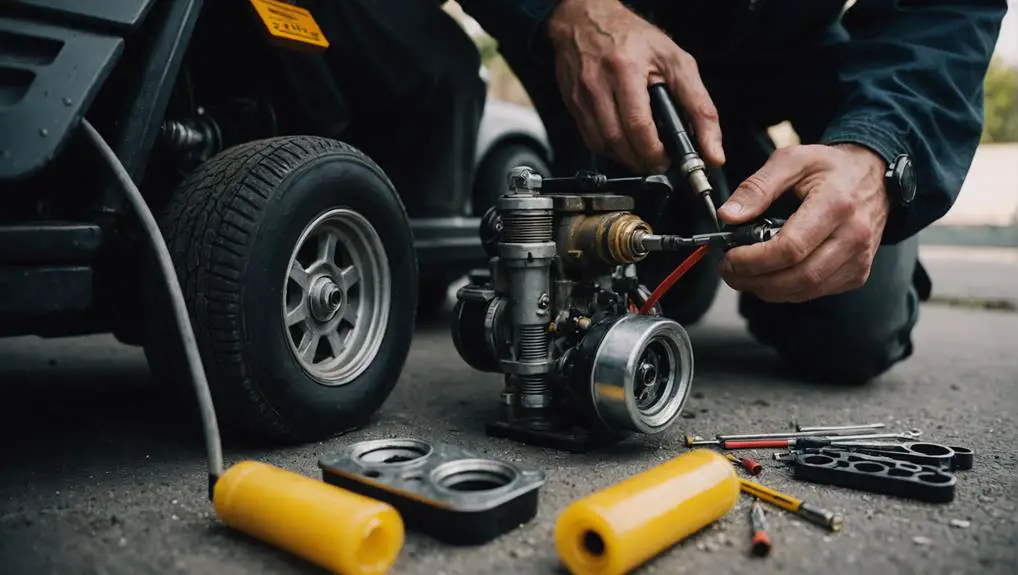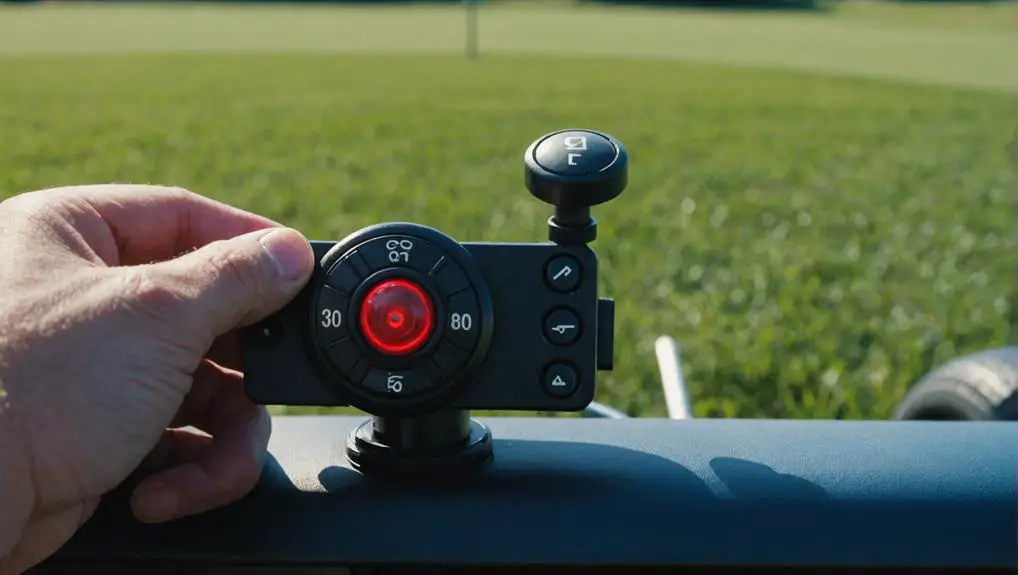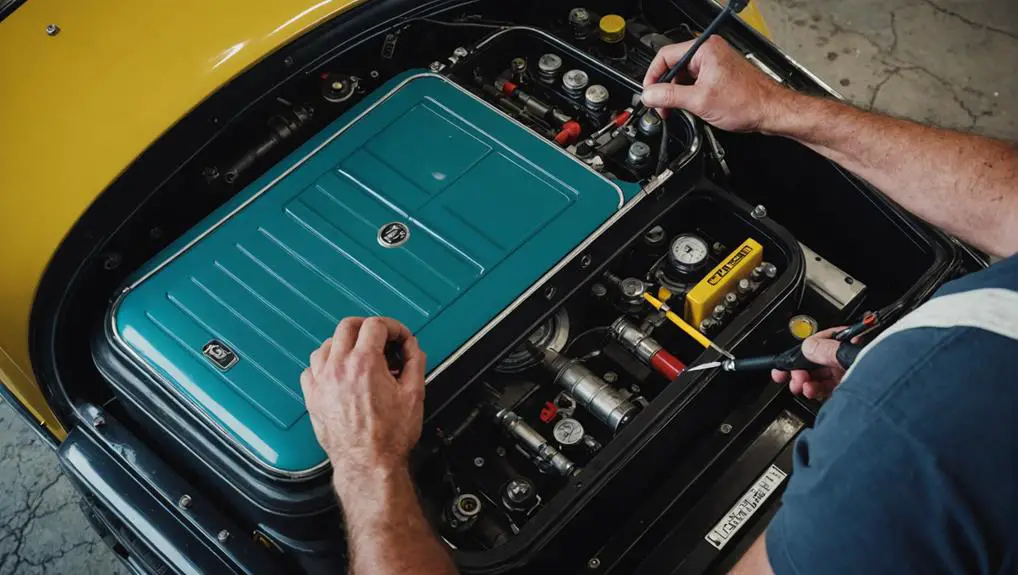When your gas golf cart won't start, it can be frustrating, but addressing the issue systematically can help you identify the problem. Start by checking the fuel level—if it's low, you might be looking at a simple fix. However, if the fuel's fine, you'll want to inspect the battery and ignition system next. Each step is vital, and missing even a small detail can lead to more confusion. So, what happens if the battery's fine but the cart still doesn't budge? Let's explore the next steps together.
Key Takeaways
- Check the fuel level and ensure it's above empty; inspect for leaks and use fresh fuel with the recommended type.
- Inspect the battery for damage or corrosion; ensure terminals are clean, tight, and the battery voltage is around 12.6 volts.
- Examine the ignition system, including spark plugs and ignition wires, for wear, damage, or improper gaps affecting starting.
- Test the starter motor by verifying voltage at its terminal; replace if it doesn't engage when power is present.
- Confirm the kill switch is in the "ON" position and review wiring connections for any issues affecting functionality.
Check the Fuel Level
Before diving into any troubleshooting, it's important to check the fuel level in your gas golf cart. A low fuel level can prevent the engine from starting, leading you to waste time on unnecessary diagnostics. Start by locating the fuel gauge, typically situated on the dashboard. Verify the gauge reads above the empty mark. If it's below, fill the tank with the appropriate fuel type recommended by the manufacturer.
Next, inspect the fuel tank for any visible leaks or damage. A compromised tank can lead to fuel loss and engine performance issues. If you notice any leaks, it's crucial to address them immediately, as they can pose safety hazards.
After refueling, try starting the cart again. If it starts, your problem was likely just a low fuel level. However, if it still won't start, proceed to the next steps in troubleshooting.
Remember that fuel quality matters too; old or contaminated fuel can cause starting problems. Always use fresh fuel and consider adding a fuel stabilizer if the cart sits unused for extended periods. This practice guarantees peak performance and reliability from your gas golf cart.
Inspect the Battery Condition
After confirming you have adequate fuel, the next step is to inspect the battery condition. A weak or dead battery can prevent your gas golf cart from starting, so it's essential to assess its status.
Start by visually examining the battery for any obvious signs of damage or corrosion.
Here are some key points to check:
- Cleanliness: Verify the battery terminals are clean and free from corrosion. Use a mixture of baking soda and water if needed.
- Connections: Tighten any loose battery cables. Loose connections can interrupt the electrical flow.
- Voltage Test: Use a multimeter to check the battery voltage. A healthy battery should read around 12.6 volts.
- Age of the Battery: Consider the battery's age. If it's over three to five years old, it might be time for a replacement.
- Fluid Levels: If your battery isn't maintenance-free, check the electrolyte levels and top up with distilled water if necessary.
Examine the Ignition System

Now, you need to examine the ignition system to guarantee your gas golf cart starts reliably.
Begin by checking the spark plug for wear and proper gap, then inspect the ignition wires for any signs of damage.
Check Spark Plug
When troubleshooting a gas golf cart, checking the spark plug is an important step in examining the ignition system. A faulty spark plug can prevent your cart from starting or lead to poor performance.
Start by locating the spark plug, usually found at the engine's top. You'll need a socket wrench to remove it safely.
Here's what to look for when checking the spark plug:
- Color: A sooty or wet appearance indicates a problem with fuel mixture or ignition.
- Electrodes: Verify they're not worn down or damaged; excessive wear means it's time for a replacement.
- Carbon Build-up: If you see significant deposits, it can hinder ignition.
- Gap Size: Measure the gap with a feeler gauge; it should match the manufacturer's specifications.
- Corrosion: Check for rust or corrosion on the terminal; clean or replace as needed.
After inspecting, if the spark plug looks good, reinsert it carefully. If it's damaged or worn, replace it to guarantee your cart starts smoothly.
A properly functioning spark plug is crucial for peak engine performance!
Inspect Ignition Wires
Inspecting the ignition wires is essential for guaranteeing your gas golf cart starts reliably and runs smoothly. Begin by visually examining the wires for any signs of wear, fraying, or damage. Look for cracks, corrosion, or loose connections that could interrupt the electrical flow. If the wires are brittle or discolored, they may need replacing.
Next, check the connections at both ends of the ignition wires. Verify they're seated tightly in the ignition coil and the spark plug. A loose connection can prevent the necessary voltage from reaching the spark plug, which is critical for starting your cart.
Also, assess the condition of the wire insulation. Damaged insulation can lead to short circuits or misfires, compromising performance. If you notice any exposed wire, wrap it with electrical tape as a temporary fix, or replace the wire altogether.
Test Ignition Coil
After confirming the ignition wires are in good condition, the next step is to test the ignition coil. The ignition coil is essential for generating the high voltage needed to ignite the fuel-air mixture in your golf cart's engine. If it's malfunctioning, your cart won't start.
Here's how you can effectively test it:
- Disconnect the battery to avoid any electrical shocks.
- Locate the ignition coil and check for any visible damage or corrosion.
- Use a multimeter to measure the resistance of the primary and secondary windings. Refer to your cart's manual for the correct values.
- Check for spark by connecting the coil to a spark plug and cranking the engine. A strong spark indicates a good coil.
- Inspect connections to verify they're tight and free of rust.
If the coil fails any of these tests, it's likely time for a replacement.
Always remember to reconnect the battery after your tests.
Test the Starter Motor
Regularly testing the starter motor is essential for guaranteeing your gas golf cart operates smoothly. A malfunctioning starter motor can prevent your cart from starting, so it's important to diagnose this component effectively.
Start by checking the battery voltage; a weak battery can mimic starter motor issues. Confirm the battery is fully charged and connect a multimeter to the battery terminals. If the reading is below 12.4 volts, recharge or replace the battery before testing the starter.
Next, locate the starter motor. Inspect the wiring for any signs of damage, corrosion, or loose connections. If everything looks good, use a multimeter to measure the voltage at the starter motor terminal while someone turns the key.
If you see voltage but the motor doesn't engage, the starter motor may be faulty. Conversely, if you don't see voltage, the problem could lie in the ignition switch or wiring.
Assess the Fuel System

A faulty starter motor can often lead to misdiagnosis of fuel system issues.
Before diving deeper, confirm you've ruled out electrical problems. Once you're confident the starter's fine, focus on the fuel system.
Start by checking the fuel level; a simple oversight can cause frustration. Next, inspect the fuel lines for any cracks or leaks. Clogged fuel filters can restrict flow, so be certain to replace them if they appear dirty.
Also, examine the fuel pump to verify it's functioning correctly. Finally, don't forget about the carburetor; a dirty or malfunctioning carb can prevent proper fuel delivery.
Here's a quick checklist to help you assess the fuel system:
- Confirm the fuel level is adequate.
- Inspect fuel lines for damage or leaks.
- Check and replace clogged fuel filters.
- Test the fuel pump for proper operation.
- Clean or service the carburetor as needed.
Look for Electrical Issues
Identifying electrical issues is essential when troubleshooting a gas golf cart. Start by checking the battery. Confirm it's fully charged and the terminals are clean and tight. Corroded or loose connections can prevent the cart from starting.
If the battery seems fine, inspect the wiring for any visible damage, such as frayed or broken wires. Pay attention to the ignition system; a faulty ignition coil can lead to starting problems.
Next, examine the fuses. A blown fuse can interrupt the power supply to critical components. Replace any blown fuses and test the system again.
If your cart has a solenoid, test it for functionality; a malfunctioning solenoid will prevent the starter from engaging.
You should also verify that the starter is operational. If it clicks but doesn't turn over, it may be damaged or require replacement.
Review the Kill Switch

After checking the electrical components, it's important to review the kill switch. This crucial component can prevent your golf cart from starting, even if everything else seems fine. The kill switch is designed to cut off power to the engine, guaranteeing safety when needed.
Here's what you should check:
- Position: Verify the kill switch is in the "ON" position.
- Connections: Inspect the wiring for any loose or corroded connections.
- Functionality: Test the switch by toggling it back and forth to confirm it engages properly.
- Indicator Lights: Look for any indicator lights on your dashboard that may signal a kill switch issue.
- Consult Manual: Refer to your golf cart's owner manual for specific kill switch troubleshooting steps.
If the kill switch is faulty, it might need replacing or repair. Always prioritize safety when working with electrical components.
By confirming that your kill switch is functioning as it should, you can eliminate this common issue as a cause for your golf cart's failure to start.
Once you've reviewed the kill switch, you can move on to the next troubleshooting steps confidently.
Inspect the Spark Plug
Inspect the spark plug for any visible damage that could affect performance.
If it's dirty, clean it thoroughly or consider replacing it altogether.
Also, make sure the gap settings are correct to maintain ideal ignition.
Check for Damage
Your golf cart's performance can greatly depend on the condition of the spark plug, making it vital to check for any damage. A faulty spark plug can lead to poor ignition and, consequently, starting issues.
Start by removing the spark plug and examining it closely for signs of wear or damage.
Look for the following indicators:
- Cracks or chips: Any visible damage can hinder performance.
- Burnt electrodes: A worn electrode can affect the spark quality.
- Carbon buildup: Excessive buildup can cause misfiring.
- Rust or corrosion: These can interrupt the electrical flow.
- Improper gap: Verify the gap is within manufacturer specifications.
If you notice any of these issues, it's a clear sign that your spark plug might be the culprit behind your cart's starting problems.
Addressing these concerns early can save you from further complications down the line.
After checking for damage, you'll be in a better position to decide whether cleaning or replacing the spark plug is the next step.
Always remember that a well-maintained spark plug is essential for your golf cart's best performance.
Clean or Replace
Once you've assessed the condition of the spark plug, the next step is to decide whether to clean or replace it. If the spark plug shows minimal wear, such as light carbon buildup or minor discoloration, cleaning it's often sufficient.
Use a wire brush or a spark plug cleaner to remove debris, making sure you don't damage the ceramic insulator. After cleaning, inspect the electrode for any signs of excessive wear or damage.
If the spark plug is heavily fouled, cracked, or exhibits significant wear, replacing it's your best option. A degraded spark plug can lead to misfires and poor engine performance. Always refer to your golf cart's manual for the correct specifications when selecting a replacement spark plug.
Additionally, make certain you're using the right tools. A spark plug socket will help you remove and install the plug without stripping it.
After cleaning or replacing, securely reattach the spark plug and check the connection to make sure it's tight. With a clean or new spark plug, you should see improved ignition performance, helping your gas golf cart start smoothly.
Proper Gap Settings
Proper gap settings play an essential role in ensuring ideal engine performance for your gas golf cart.
When the spark plug gap isn't set correctly, it can lead to inefficient combustion, resulting in starting issues or poor engine performance.
To inspect and adjust the spark plug gap, follow these steps:
- Gather tools: You'll need a spark plug gap tool, a socket wrench, and possibly a feeler gauge.
- Remove the spark plug: Disconnect the spark plug wire and use a socket wrench to take it out carefully.
- Check the gap: Use the gap tool or feeler gauge to measure the distance between the center and ground electrodes.
- Adjust if necessary: If the gap is too wide or narrow, gently bend the ground electrode to achieve the manufacturer's specified gap.
- Reinstall the spark plug: After adjusting, reinstall the spark plug, ensuring it's properly tightened and the wire is reconnected.
Check Engine Oil Levels

Checking engine oil levels is essential for maintaining the performance of your gas golf cart. Low or dirty engine oil can lead to inadequate lubrication, increased friction, and engine damage, which can prevent your cart from starting.
To check the engine oil, locate the dipstick, usually found near the engine compartment. Remove the dipstick, wipe it clean with a cloth, and reinsert it fully. Pull it out again to check the oil level. The oil should be between the minimum and maximum marks on the dipstick. If it's below the minimum mark, you'll need to add oil.
When adding oil, make sure you use the recommended type for your golf cart. Pour in small amounts at a time, rechecking the level frequently to avoid overfilling. If the oil appears dark or gritty, it's time for an oil change.
After verifying the oil level and quality, secure the dipstick and close the engine compartment.
Regularly checking your engine oil helps prevent starting issues and prolongs the life of your gas golf cart. Keep up with this maintenance to guarantee peak performance.
Consult the Owner's Manual
Consulting the owner's manual is essential for troubleshooting your gas golf cart effectively. This document provides vital information that can help you identify and resolve issues quickly. When you encounter a starting problem, refer to the manual for guidance specific to your model.
Here are some key points to look for:
- Starting Procedures: The manual often outlines the correct steps to start your cart, including any necessary pre-start checks.
- Troubleshooting Guides: Many manuals include troubleshooting sections that detail common starting issues and their solutions.
- Wiring Diagrams: Understanding the wiring can help you identify electrical problems that may prevent your cart from starting.
- Maintenance Schedules: Regular maintenance tips can help you avoid issues that lead to starting failures.
- Parts Specifications: Knowing the correct parts to use can be significant if you need replacements or repairs.
Always keep your owner's manual handy, as it's an invaluable resource. By following its instructions, you can save time and potentially costly repairs while ensuring your gas golf cart gets back on the course as soon as possible.
Frequently Asked Questions
How Can Weather Affect My Gas Golf Cart's Starting Ability?
Weather can greatly impact your gas golf cart's starting ability. Cold temperatures can thicken the oil, making it harder for the engine to crank.
Additionally, moisture in the air can lead to fuel line condensation, which may cause fuel delivery issues. High humidity can also affect the ignition system, potentially leading to misfires.
Always make sure your cart's battery is fully charged and the fuel is appropriate for the current weather conditions.
What Tools Do I Need for Basic Troubleshooting?
For basic troubleshooting, you'll need a multimeter to check electrical connections and battery voltage.
A set of wrenches and sockets will help you access various components.
Don't forget a screwdriver for securing or removing panels.
A fuel pressure gauge is essential for evaluating the fuel system.
Finally, having a spark tester handy allows you to diagnose ignition issues.
Gathering these tools will prepare you for effective troubleshooting.
Can a Low Tire Pressure Cause Starting Issues?
You might think low tire pressure wouldn't affect starting, but it can.
If your tires are considerably under-inflated, it increases the load on the engine, making it work harder. This extra strain can lead to starting issues, especially in older models.
Regularly checking tire pressure guarantees peak performance. So, before diving into more technical problems, give those tires a quick look. It's a simple check that could save you time and frustration.
How Often Should I Perform Regular Maintenance on My Golf Cart?
You should perform regular maintenance on your golf cart at least every six months or after every 100 hours of use, whichever comes first.
This includes checking the oil, air filter, and battery, as well as inspecting the tires and brakes.
Staying proactive with maintenance not only enhances performance but also extends your cart's lifespan.
Are There Any Specific Warning Signs Before a Complete Failure?
Yes, there are specific warning signs you should watch for.
If you notice unusual noises, decreased performance, or difficulty starting, these could indicate underlying issues.
Additionally, pay attention to warning lights on the dashboard and any leaks beneath the cart.
If the battery struggles to hold a charge or you experience erratic behavior in the electrical system, it's time to investigate further.
Ignoring these signs could lead to a complete failure.
Conclusion
To wrap up, troubleshooting a gas golf cart that won't start involves a systematic approach. By checking fuel levels, inspecting the battery, and examining the ignition system, you can pinpoint the issue. Remember, a golf cart is only as reliable as its components; neglecting even one could leave you stranded. Stay proactive with maintenance, and consult the owner's manual for detailed guidance. With these steps, you'll be back on the course in no time.